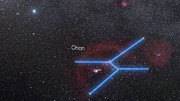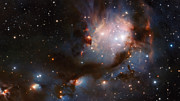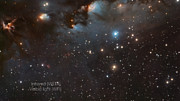VISTA views Messier 78
Messier 78: a reflection nebula in Orion
Comparisons between parts of the Messier 78 region in visible and infrared light
Videos

Zooming into VISTA’s view of Messier 78

Panning across VISTA’s view of Messier 78
In this new image of the nebula Messier 78, young stars cast a bluish pall over their surroundings, while red fledgling stars peer out from their cocoons of cosmic dust. To our eyes, most of these stars would be hidden behind the dust, but ESO’s Visible and Infrared Survey Telescope for Astronomy (VISTA) sees near-infrared light, which passes right through dust. The telescope is like a giant dustbuster that lets astronomers probe deep into the heart of the stellar environment.
Messier 78, or M78, is a well-studied example of a reflection nebula. It is located approximately 1600 light-years away in the constellation of Orion
(The Hunter), just to the upper left of the three stars that make up
the belt of this familiar landmark in the sky. In this image, Messier 78
is the central, bluish haze in the centre; the other reflection nebula
towards the right goes by the name of NGC 2071. The French astronomer Pierre Méchain
is credited with discovering Messier 78 in 1780. However, it is today
more commonly known as the 78th entry in French astronomer Charles Messier’s catalogue, added to it in December of 1780.
When observed with visible light instruments, like ESO’s Wide Field Imager at the La Silla Observatory, Messier 78 appears as a glowing, azure expanse surrounded by dark ribbons (see eso1105). Cosmic dust
reflects and scatters the light streaming from the young, bluish stars
in Messier 78’s heart, the reason it is known as a reflection nebula.
The dark ribbons are thick clouds of dust that block the
visible light originating behind them. These dense, cold regions are
prime locations for the formation of new stars. When Messier 78 and its neighbours are observed in the submillimetre light between radio waves and infrared light, for example with the Atacama Pathfinder Experiment
(APEX) telescope, they reveal the glow of dust grains in pockets just
barely warmer than their extremely cold surroundings (see eso1219).
Eventually new stars will form out of these pockets as gravity causes them to shrink and heat up.
In between visible and submillimetre light lies the near-infrared part of the spectrum, where the Visible and Infrared Survey Telescope for Astronomy
(VISTA) provides astronomers with crucial information. Beyond dusty
reflections and through thinner portions of obscuring material, the
luminous stellar sources within Messier 78 are visible to VISTA’s eyes.
In the centre of this image, two blue supergiant
stars, called HD 38563A and HD 38563B, shine brightly. Towards the
right of the image, the supergiant star illuminating NGC 2071, called HD
290861, is also seen.
Besides big, blue, hot stars, VISTA can also see many stars
that are just forming within the cosmic dust strewn about this region,
their reddish and yellow colours shown clearly in this image. These
colourful fledgling stars can be found in the dust bands around NGC 2071
and along the trail of dust running towards the left of the image. Some
of these are T Tauri stars. Although relatively bright, they are not yet hot enough for nuclear fusion
reactions to have commenced in their cores. In several tens of millions
of years, they will attain full “starhood”, and will take their place
alongside their stellar brethren lighting up the Messier 78 region.
More Information
ESO is the foremost intergovernmental astronomy organisation in Europe
and the world’s most productive ground-based astronomical observatory by
far. It is supported by 16 countries: Austria, Belgium, Brazil, the
Czech Republic, Denmark, France, Finland, Germany, Italy, the
Netherlands, Poland, Portugal, Spain, Sweden, Switzerland and the United
Kingdom, along with the host state of Chile. ESO carries out an
ambitious programme focused on the design, construction and operation of
powerful ground-based observing facilities enabling astronomers to make
important scientific discoveries. ESO also plays a leading role in
promoting and organising cooperation in astronomical research. ESO
operates three unique world-class observing sites in Chile: La Silla,
Paranal and Chajnantor. At Paranal, ESO operates the Very Large
Telescope, the world’s most advanced visible-light astronomical
observatory and two survey telescopes. VISTA works in the infrared and
is the world’s largest survey telescope and the VLT Survey Telescope is
the largest telescope designed to exclusively survey the skies in
visible light. ESO is a major partner in ALMA, the largest astronomical
project in existence. And on Cerro Armazones, close to Paranal, ESO is
building the 39-metre European Extremely Large Telescope, the E-ELT,
which will become “the world’s biggest eye on the sky”.
Links
Contact
Richard Hook
ESO Public Information Officer
Garching bei München, Germany
Tel: +49 89 3200 6655
Cell: +49 151 1537 3591
Email: rhook@eso.org
ESO Public Information Officer
Garching bei München, Germany
Tel: +49 89 3200 6655
Cell: +49 151 1537 3591
Email: rhook@eso.org
Source: ESO



